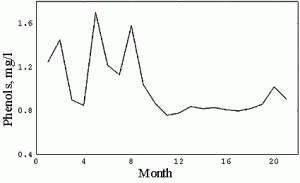Institute of Biophysics, SB RAS, Krasnoyarsk
Head of the Institute:
Andrey G.Degermendzhy, Doctor of Physical and Mathematics Sciences
Academgorodok, Krasnoyarsk, 660036, Russia
Tel. (7-3912) 431 179, Fax: (7-3912) 433 400
email: ibp@ibp.krasnoyarsk.su
Principal researchers:
Yu.L.Gurevich, Ph.D.
Project objectives
To develop the knowledge of and to understand the microbial biodiversity of soils and water bodies, effects of microbiological transformation of organic and inorganic matter, including the turnover of biogenic elements, on the mobility of heavy metals, degradation of contaminants and sustenance of soil fertility in mineral resource exploitation, land use, waste dump sites.
To collect data on the activity, diversity of Fe-, S-oxidising bacteria at the sites of occurrence and development of sulphide ores, in areas with temperate and cold climate, as well as the mobility of heavy metals.
To gain a more profound insight into the effect of microflora of soils and water bodies (microorganisms and protozoa) on the mobility of phosphorus, soil fertility and degradation of compounds of technogenic origin (bio- and phytoremediation).
Background and significance of objectives
Methods for isolating microorganisms with certain functional properties employing a continuous cultivation technique have been developed. Selection employing design and technological procedures resulted in pure and mixed cultures to degrade aromatic carbohydrates, surfactants, to study kinetic characteristics of microorganisms and peculiarities of biodegradation of toxic compounds.
A method has been developed for introducing active strains and forming mixed microorganism culture with the structure most efficient in degrading toxic agents. The method has been tested in biological purification of phenol wastewater under industrial conditions.
Data on the functioning of a community of microorganisms and protozoa under technogenic load have been collected. This component is vital for the transformation and mobility of substances in soil and water systems. A specific effect of the forming microorganism film on biodegradation of toxic compounds has been demonstrated experimentally and by a mathematical model. Essential factors of bacterial aggregation and certain specific effects of this phenomenon in degrading a substance and transfer of plasmids have been studied.
The biodiversity of protistoplankton and bacterioplankton of Lake Khanka (Far East) has been investigated. Silicate and other microorganisms featuring an elevated capacity of transferring biogenous elements from poorly solved compounds (phosphorites, potassium aluminium silicates) to mobile states have been isolated. Strains of psychrophylic microorganisms have been isolated in areas with steady low temperature (Krasnoyarsk Kray). Experience has been gained in isolating and studying iron-oxidising bacteria responsible for leaching sulphide minerals.
Methods have been developed for studying matter transformation in microcosms where plant residues decompose in ìplants-mushrooms-worms-microorganismsî systems. The system forms a soil-like substrate and simulates matter turnover in the soil system. In the course of a year plants may undergo 3-4 vegetation cycles and, accordingly, reduce time to study phytoremediation processes.
Migration of heavy metals in soils and water system largely depends on microbiological transformation of minerals. A great contribution into the process is made by iron- and sulphur-oxidising bacteria, as well as microorganisms capable of destructuring poorly solved compounds (potassium aluminium silicates, phosphorites). To collect data on this microflora at sites with high technological activity in temperate and cold climate areas, it is necessary to evaluate status of the environment and to better understand trends of its development.
The effect of mobile phosphorus on behaviour of heavy metals is, on the whole, known, but it has never been studied in connection with the activity of iron-oxidising bacteria. Dissolution of phosphorites involves many microorganism species, among them ñ nonspecific. The isolated silicate microorganisms can play an important role in supplying biogenous elements (primarily ñ phosphorus and potassium) for biological processes in soils and water bodies.
However, releasing phosphorus from poorly dissolved compounds may be interesting from the viewpoint of its considerable effect on degradation of organic compounds. An increasing supply of plants with phosphorus eliminates the limitation of processes by the vital biogenous element. At the same time roots increase emission of exudates, which are the substrate for microorganisms. As a result, microbiological processes enhance their intensity and elevated mobility of phosphorus and activity of microorganisms establish feedback. Rhizosphere is the first to manifest emission of exudates. All this makes investigation of biodecomposition of poorly dissolved phosphorus compounds important for a better understanding of the effect of contaminants on biodegradation and phytoremediation. Of special interest for cold climate areas is biodegradation of contaminants by psychrophilic microorganisms.
Ripple effects of this research is to evaluate feasibility of using the isolated bacteria with elevated activity in biotechnology, viz. to process mineral raw material and in bioremediation.
Research plan: approaches and methods
To isolate microorganisms belonging to specific physiological groups (iron- sulfur-oxidising, silicate, psychrophilic). To evaluate their specific activity in an increasing mobility of heavy metals and the capacity of taking part in degrading toxic compounds. Mathematical simulation of microbiological processes.
To examine:
- sites with considerable industrial activity processing sulphide ores of non-ferrous and noble metals;
- deposits of analogous undeveloped ores;
- toiled agricultural lands and soils in areas with a higher technological risk, to investigate the activity of microflora dissolving phosphorites and potassium aluminium silicates.
Methods. Field and laboratory studies of the microbial diversity of objects by conventional microbiological methods and continuous cultivation. These methods are used to study capacity of isolated microorganisms and communities to degrade contaminants and transform wastes. The continuous cultivation technique is more suitable for evaluating degradation of contaminants in aquatic systems. To study phytoremediation, it is proposed to develop experimental models ìsoil-plants-microorganismsî. This system is to study the mobility of phosphorus and the effect of microorganisms degrading contaminants.
Expected results
To develop a database on microflora of temperate and cold climate areas of Krasnoyarsk Kray:
- on iron- and sulphur-oxidising microorganisms in mining sulphide ores enhancing the mobility and migration of heavy metals;
- microflora active and specific for dissolution of phosphorites and potassium aluminium silicates in certain deposits (poorly soluble compounds of P and K in soils);
- to obtain quantitative estimates of the ability of the most active microorganisms to destroy contaminants (aromatic carbohydrates and petroleum carbohydrates).
List of publications of participants related to the project
-
Gurevich Yu.L. Stability and growth regulation in microbial populations. ñ Novosibirsk: Nauka, 1984. (in Russian).
-
Gurevich Yu.L., Ladygina V.P. Biofilm growth and stability of the biodegradation of toxic compounds in continuous systems. In: Problems of ecological monitoring and ecosystem modelling. ñ Leningrad: Gidrometeoizdat, 1986. ñ π 9. ñ P. 22– 30 (in Russian).
-
Bebyakin Y.I., Gurevich Yu.L., Teremova M.I. et al. Method of microbial consortium receiving for the biological water treatment of coke-chemical plants. Pat. RUS. 1987. π 1364608.
-
Gurevich Yu.L., Ladygina V.P. The stability of biodegradation of toxic substrates in a chemostat with respect to cells attachment // 9th ISCC ìCont. Culture in biotechnol. and environ. conservationî, Books of Abstr. Hradec Kralove. Czeck. ñ 1987.
-
Gurevich Yu.L., Teremova M.I. et al. Increasing of efficiency of the phenol water biological treatment // Koks i Khimiya. ñ 1989. ñ π 1. ñ P. 51– 52 (in Russian).
-
Gurevich Y.L., Ladygina V.P. Effect of protozoa on the bacterial degradation of aromatic hydrocarbons // Stud. Environ. Sci. / Environ. Biotechnol. ñ 1991. ñ π 42. ñ P. 147– 153.
-
Manukovski N.S., Teremova M.I., Gurevich Y.L., Pan¢ kova I.M. Phenol and naphthalene degradation by mixed culture of microorganisms // ibid. ñ P. 155– 163.
-
Gurevich Yu.L., Ladygina V.P., Teremova M.I. Degradation of technogenic flows of organic matter by communities of microorganisms and ciliates // Biol. Bull. (transl. from Izv. Akad. Nauk). ñ 1995. ñ π 22. ñ P. 226– 230.
-
Belyi A.V., Gurevich Yu.L., Pustoshilov P.P., Kadochnicova G.G. Oxidizing of elemental sulphur by Thiobacillus ferrooxidans // Appl. Biochem. and Microbiol. (Transl. from Prikl. Biokhimiya i Mikrobiol.). ñ 1997. ñ π 33. ñ P. 564-567.
-
Manukovsry N.S., Kovalev V.S., Rygalov V.Ye., Zolotukhin I.G. Waste Biodegradation in Life Support CES: Development of Soil Organic Substrate // Adv. Space Res. ñ 1997. ñ π 20. ñ P. 1827-1832.
-
Gurevich Yu.L., Teremova M.I., Latyincheva ¿.V. Flocculation of bacterial cells in culture with protozoa // Biol. Bull. ñ 1998. ñ π 25. ñ P. 282-285. (transl. from Izv. Akad. Nauk.).
-
Beliy ¿.V., Gurevich Y.L., Pustochilov P.P., Sadovsky M.G. Biotechnological Implementations for the Radioactive Wastes Disposal. Defence Nuclear Wastes Disposal in Russia / Eds. M.Stenhouse and V.Kirko. ASI Series. Amsterdam: Kluwer. ñ 1998. ñ π 28. ñ P. 303-308.
-
Manukovsry N.S., Gurevich Y.L., Kovalev V.S., Petrov A.I. Bacterial consortium Pseudomonas sp., Pseudomonas fluorescens, Pseudomonas putida, Thiobacillus sp., to use the water treatment from alkyl sulphonate. Patent Russia. ñ 1998. ñ π 2103356.
-
Ladygina V.P., Gurevich Y.L. Protozooplankton community in lake Hanka // Biol. Bulletin. ñ 1999. (in press).
Fig. 1. Result of the exchange of the bacterial community structure (1 ñ 8 months indigenous or initial structure, in succeeding ñ changed).
Fig. 2. The effect of Fe-, S-oxidizing bacteria on mobility of metals under mine development.


